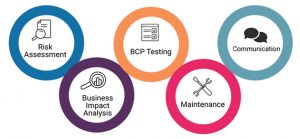In order to define a BCP for a cloud computing environment you need to right-fit your BCP in relation to business requirements, impact assessments, and real metrics. You must also define it in the context of the company’s larger enterprise architecture, which may include applications and systems.
This means the strategy must be resilient enough to enable recovery in the worst-case situation, but not over-engineered with features and requirements that the business does not require. You don’t want to fall into the trap of incurring needless and recurring costs as a result of an over-engineered solution.
So, to clarify some of the decisions that architects must make, let’s break down a robust BCP into individual components. It’s critical to recognize that business continuity is a comprehensive solution that encompasses people, processes, and technology.

High availability – High Availability refers to the set of processes in place to ensure that services, applications, and data are available at all times. This notion, as well as the underlying HA technologies enables enterprises to meet uptime SLAs such as the “high four nines percent (99.99%)” and so on. For routine outages caused by hardware failure, network failure, load-induced outage, or another application failure, high availability processes and technologies are in place. The following are examples of high-availability events:
- Hardware failure — This could be a single server component, a network switch, cabling, or another physical dependency that causes an outage.
- “Split-brain” scenarios — such situation occurs when the network link between cluster nodes fails temporarily, causing both nodes to switch to the leader (primary) role while separated. This could result in new data being created on both nodes without being copied to the other. As a result, two diverging sets of data have most likely been formed in this case, which cannot be easily united.
Disaster recovery – While high availability protects you from more frequent service outages, disaster recovery safeguards your data in the event of a significant calamity. While the goal of high availability is to maintain uptime regularly, disaster recovery is necessary when severe disruptions occur. All of the circumstances that which high availability isn’t designed to manage are taken into account in disaster recovery. What are some real-life examples of disaster recovery?
- Natural calamities – Natural disasters like as earthquakes, fires, floods, tornadoes, and hurricanes are rare occurrences that far outweigh the business-continuity benefits of high availability.
- A DDoS attack – A distributed denial-of-service (DDoS) attack is an attempt to disrupt a targeted server’s, service’s, or network’s normal traffic by overloading the target or its working system with Internet activity. A DDoS assault is analogous to an unanticipated traffic congestion obstructing the roadway, preventing ordinary traffic from reaching its destination.
Why Are High Availability (HA) and Disaster Recovery (DR) Necessary?
To achieve business continuity, it’s critical to use both high availability and disaster recovery solutions. As previously said, high availability protects you from everyday events that can cause system downtime, such as hardware failure, network failure, load-induced outage, or another application failure.
A highly available system is one that has high availability processes and technology in place to ensure that these types of failures have little or no impact on business. When a major outage occurs as a result of natural catastrophes, A DDoS attack, hardware failure, or site-wide failures, disaster recovery comes into play.
By collecting backups of business-critical systems and preserving offsite DR copies, you can have robust backups of business-critical systems and offsite DR copies. Replication protects you in the event of a site-wide disaster, in which the entire site may go down.
If the primary production site goes down, resources can be redirected to the DR site by replicating virtual computers to a DR facility. Both high availability and disaster recovery are crucial in business continuity planning. Each plays a critical role in ensuring daily uptime as well as data recovery in the event of a major calamity.
Conclusion
It takes time to plan right business continuity strategy, but it save company’s lot of resources and data in the long term. It makes no difference how strong your servers are if they aren’t up and running. Based upon the business transactions and data criticality, big companies should review their backup strategies and adopt the right disaster recovery and high availability solutions to achieve business continuity, it’s critical to use both high availability and disaster recovery solutions in place.
